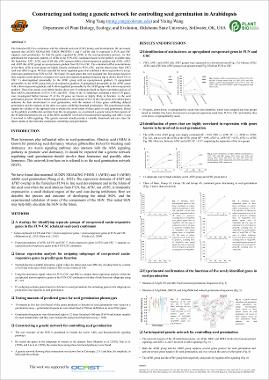| dc.contributor.author | Yang, Ming | |
| dc.contributor.author | Wang, Yixing | |
| dc.date.accessioned | 2023-10-20T14:48:31Z | |
| dc.date.available | 2023-10-20T14:48:31Z | |
| dc.date.issued | 2023-06-05 | |
| dc.identifier | oksd_yang_constructing_and_testing_a_2023 | |
| dc.identifier.citation | Yang, M., Wang, Y. (2023). Constructing and testing a genetic network for controlling seed germination in Arabidopsis. | |
| dc.identifier.uri | https://hdl.handle.net/11244/339849 | |
| dc.description.abstract | The funiculus (FUN) is continuous with the chalazal seed coat (CSC) during seed development. We previously reported that AUXIN SIGNALING F-BOX PROTEIN 1 and 5 (AFB1 and 5) expressed in FUN and CSC suppress seed germination. To find the genes regulated by AFBs in the seed germination process, we first determined the expression patterns of AFBs in the FUN-CSC continuum based on the publicly available data. We found that TIR1, AFB1, and AFB4 (the AFB1 group) exhibit a down-expression gradient and AFB2, AFB3, and AFB5 (the AFB5 group) an up-expression gradient from FUN to CSC. The estimated mRNA concentrations of the three AFBs in each group are highly linearly correlated in FUN, CSC, and the distal (away from CSC) seed coat (DSC) region. We then searched for auxin-regulated genes that exhibited a down-expression or an up- expression gradient from FUN to CSC. We found 118 such genes that were assigned into four groups based on their response mode (positive or negative) to auxin and expression gradient direction (up or down) from FUN to CSC: 1) downregulated presumably by the AFB1 group with an up-expression gradient, 2) upregulated presumably by the AFB5 group with an up-expression gradient, 3) upregulated presumably by the AFB1 group with a down-expression gradient, and 4) downregulated presumably by the AFB5 group with a down-expression gradient. These four groups were further broken down into 12 subgroups based on linear correlation analysis of their mRNA concentrations in FUN, CSC, and DSC. Three of the 12 subgroups, including a total of 30 genes, were investigated further because 21 of the 30 genes are known or highly likely to function in the seed germination process. We have tested seed germination in the mutants of five of the nine genes (two alleles/gene) unknown for their involvement in seed germination, with the mutants of three genes exhibiting delayed germination and the mutants of the other two genes exhibiting hastened germination. The experimental results support the validity of the approach used to predict the involvement of these genes in seed germination. Based on the publicly available data and data from this investigation, we constructed a genetic network that consists of the 30 identified proteins, the six AFBs, BES1 and BZR1 involved in brassinosteroid signaling, and ABI3, 4, and 5 involved in ABA signaling. This genetic network should provide a valuable framework and new clues for future studies of the molecular mechanism controlling seed germination. | |
| dc.format | application/pdf | |
| dc.rights | This material has been previously published. In the Oklahoma State University Library's institutional repository this version is made available through the open access principles and the terms of agreement/consent between the author(s) and the publisher. The permission policy on the use, reproduction or distribution of the material falls under fair use for educational, scholarship, and research purposes. Contact Digital Resources and Discovery Services at lib-dls@okstate.edu or 405-744-9161 for further information. | |
| dc.title | Constructing and testing a genetic network for controlling seed germination in Arabidopsis | |
| dc.date.updated | 2023-10-17T21:33:54Z | |
| osu.filename | oksd_yang_constructing_and_testing_a_2023.pdf | |
| dc.description.department | Plant Biology, Ecology and Evolution | |
| dc.type.genre | Presentation | |
| dc.type.material | Text | |
| dc.identifier.author | ORCID: 0000-0002-7499-3338 (Yang, Ming) | |
| dc.identifier.author | ScopusID: 57151591400 (Yang, Ming) | |
